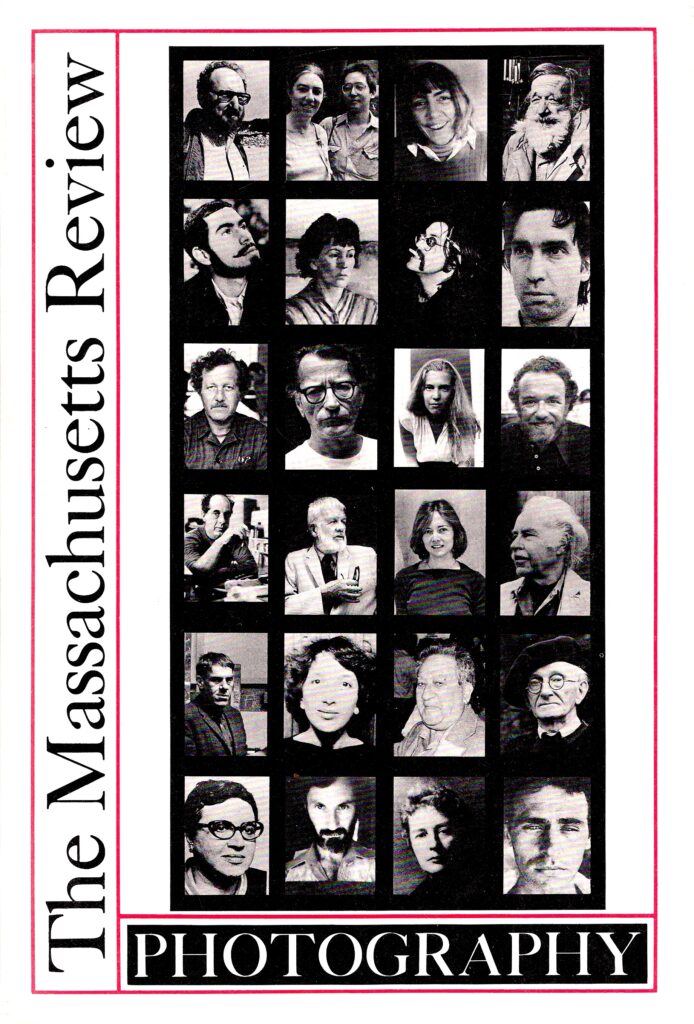Volume 19, Issue 4

Table of Contents
Photography: Introduction, by Jerome Liebling
In Our Image, Non-Fiction by Wright Morris
Photography, Non-Fiction by Walker Evans
The Romantic Machine: Towards a Definition of Humanism, Non-Fiction by Bill Jay
August Sander, Non-Fiction by Anne Halley
Photography as a Universal Language, Non-Fiction by August Sander
Icons or Ideology: Stieglitz and Hine, Non-Fiction by Estelle Jussim
Photography and the Institution: Szarkowski at the Modern, Non-Fiction by Maren Stange
The Bus Show, Non-Fiction by Kate Carlson and Bill Arnold
Sentiment, Compassion, Straight Record: The Mid-Victorians, Non-Fiction by Elizabeth Lindquist-Cock
The Photographs of Helen Levitt, Non-Fiction by Roberta Hellman and Marvin Hoshino
PHOTOGRAPHIC SIGNATURE
Photographs by Helen Levitt, Walker Evans, August Sander, Sally Stein, Robert Frank, Lewis Hine, Alfred Stieglitz, John Szarkowski, Jerome Liebling, Robert Wilcox
Photography and the World’s Body, Non-Fiction by Roger Copeland
Form and Content in the Early Work of Aaron Siskind, Non-Fiction by Carl Chiarenza
Camera Work: Notes Toward an Investigation, Non-Fiction by Alan Trachtenberg
Dismantling Modernism, Reinventing Documentary (Notes on the Politics of Representation), Non-Fiction by Allan Sekula
A Few Alternatives, Non-Fiction by Paul Vanderbilt
Contributors
Walker Evans (1903-1975) was one of America’s foremost photographers. His well-known books include Let Us Now Praise Famous Men (with James Agee), Messages From the Interior, and Many Are Called.
Robert Frank has been actively involved as a film maker since publishing his master work in photography, The Americans.
Anne Halley is a poet and fiction writer, has translated Kurt Tucholsky’s book Deutschland, Deutschland Uber alles.
Roberta Hellman and Marvin Hoshino have written for The Village Voice and Arts Magazin.
Bill Jay, Professor of Photography at Arizona State, is a writer and editor.
Estelle Jussim teaches Film and Visual Communication in the Graduate School of Simmons College, Boston. She is the author of Visual Communication and the Graphic Arts (1974).
Helen Levitt is a well-known photographer and film maker. Her films include In the Street and The Quiet One (with James Agee and Janice Loeb). Her book of photographs is called A Way of Seeing.
Jerome Liebling is professor of Film and Photography at Hampshire College. He has exhibited widely and is the subject of a recent monograph written by Estelle Jussim and published by Friends of Photography (Carmel, California).
Elizabeth Lindquist-Cock has recently published Influence of Photography on American Landscape Painting.
Robert Lyons, photographer and photography conservationist, is presently studying at Yale University.
Wright Morris, author and photographer, has long been concerned in relating photography and literary text. His books include The Inhabitants, The Home Place, and God’s Country and My People. A forthcoming book, Earthly Delights, Unearthly Adornments, concerns American writers as image-makers.
August Sander (1876-1964) was a distinguished German photographer whose masterwork, Men Without Masks continues to exert influence on new generations of photographers.
Allan Sekula teaches at the University of California, San Diego, works with video as well as photography.
Aaron Siskind, among the foremost of American photographers, works from his home in Providence, Rhode Island. The bulk of his work is now with the Photographic Center, University of Arizona in Tucson.
Maren Stange is completing her Ph.D. in American Studies at Boston University. She has written on photography for the New Boston Review.
Sally Stein received her M.F.A. from the Rhode Island School of Design, and teaches photographic history at Parsons School of Design.
John Szarkowski, author of The Idea of Louis Sullivan (1956) and The Face of Minnesota (1958), is presently director of photography at the New York Museum of Modern Art.
Alan Trachtenberg, professor of American Studies at Yale University, has written extensively on aspects of American culture and photography.
Paul Vanderbilt studied with Clarence White, Sr., worked with Roy Stryker, held the Chair of Fine Arts at the Library of Congress, and is Curator emeritus for the Wisconsin State Historical Society.
Robert Wilcox (1925-1970) lived and worked in Wisconsin and Minnesota and graduated from the University of Minnesota. His work is in the Robert Wilcox Collection of the Minneapolis Institute of Art.


